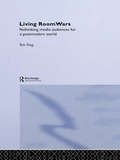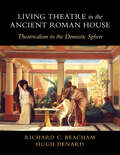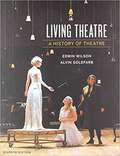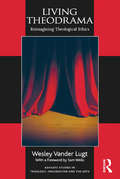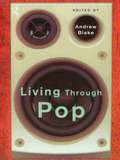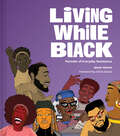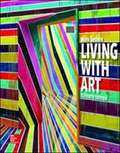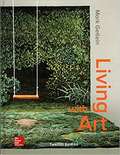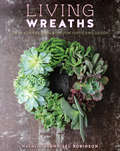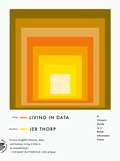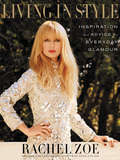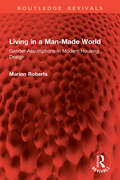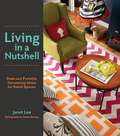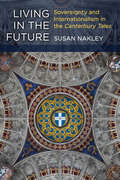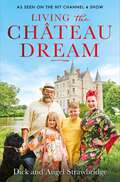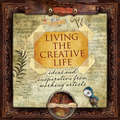- Table View
- List View
Living Pictures, Missing Persons: Mannequins, Museums, and Modernity
by Mark B. SandbergIn the late nineteenth century, Scandinavian urban dwellers developed a passion for a new, utterly modern sort of visual spectacle: objects and effigies brought to life in astonishingly detailed, realistic scenes. The period 1880-1910 was the popular high point of mannequin display in Europe. Living Pictures, Missing Persons explores this phenomenon as it unfolded with the rise of wax museums and folk museums in the largest cities of Denmark, Sweden, and Norway. Mark Sandberg asks: Why did modernity generate a cultural fascination with the idea of effigy? He shows that the idea of effigy is also a portal to understanding other aspects of visual entertainment in that period, including the widespread interest in illusionistic scenes and tableaux, in the "portability" of sights, spaces, and entire milieus. Sandberg investigates this transformation of visual culture outside the usual test cases of the largest European metropolises. He argues that Scandinavian spectators desired an unusual degree of authenticity--a cultural preference for naturalism that made its way beyond theater to popular forms of museum display. The Scandinavian wax museums and folk-ethnographic displays of the era helped pre-cinematic spectators work out the social implications of both voyeuristic and immersive display techniques. This careful study thus anticipates some of the central paradoxes of twentieth-century visual culture--but in a time when the mannequin and the physical relic reigned supreme, and in a place where the contrast between tradition and modernity was a high-stakes game.
Living Quixote: Performative Activism in Contemporary Brazil and the Americas (Performing Latin American and Caribbean Identities)
by Rogelio MinanaThe 400th anniversaries of Don Quixote in 2005 and 2015 sparked worldwide celebrations that brought to the fore its ongoing cultural and ideological relevance. Living Quixote examines contemporary appropriations of Miguel de Cervantes's masterpiece in political and social justice movements in the Americas, particularly in Brazil.In this book, Cervantes scholar Rogelio Miñana examines long-term, Quixote-inspired activist efforts at the ground level. Through what the author terms performative activism, Quixote-inspired theater companies and nongovernmental organizations deploy a model for rewriting and enacting new social roles for underprivileged youth. Unique in its transatlantic, cross-historical, and community-based approach, Living Quixote offers both a new reading of Don Quixote and an applied model for cultural activism—a model based, in ways reminiscent of Paulo Freire, on the transformative potential of performance, literature, and art.
Living Quixote: Performative Activism in Contemporary Brazil and the Americas (Performing Latin American and Caribbean Identities)
by Rogelio MinanaThe 400th anniversaries of Don Quixote in 2005 and 2015 sparked worldwide celebrations that brought to the fore its ongoing cultural and ideological relevance. Living Quixote examines contemporary appropriations of Miguel de Cervantes's masterpiece in political and social justice movements in the Americas, particularly in Brazil. In this book, Cervantes scholar Rogelio Miñana examines long-term, Quixote-inspired activist efforts at the ground level. Through what the author terms performative activism, Quixote-inspired theater companies and nongovernmental organizations deploy a model for rewriting and enacting new social roles for underprivileged youth. Unique in its transatlantic, cross-historical, and community-based approach, Living Quixote offers both a new reading of Don Quixote and an applied model for cultural activism—a model based, in ways reminiscent of Paulo Freire, on the transformative potential of performance, literature, and art.
Living Roofs in Integrated Urban Water Systems
by Daniel Roehr Elizabeth Fassman-BeckWith the infrastructure to manage storm water threats in cities becoming increasingly expensive to build or repair, the design community needs to look at alternative approaches. Living roofs present an opportunity to compliment ground-level storm water control measures, contributing to a holistic, integrated urban water management system. This book offers tools to plan and design living roofs, in the context of effectively mitigating storm water. Quantitative tools for engineering calculations and qualitative discussion of potential influences and interactions of the design team and assembly elements are addressed.
Living Room Wars: Rethinking Media Audiences
by Ien AngLiving Room Wars brings together Ien Ang's recent writings on television audiences, and , in response to recent criticisms of cultural studies, argues that it is possible to study audience pleasures and popular television in a way that is not naively populist. Ang examines how the makers and marketers of television attempt to mould their audience and looks at the often unexpected ways in which the viewers actively engage with the programmes they watch. Living Room Wars highlights the inherent contradictions of a `politics of pleasure' of television consumption: Ang moves beyond the trditional forcus on textual meanings to explore the structural and historical representations fo television audiences as an integral part of modern culture. Her wide-ranging and illuminating discussion takes in the battle between television and its audiences; the politics of empirical audience research; new technologies and the tactics of television consumption; ethnography and radical contextualism in audience studies; television fiction and women's fantasy; feminist desire and female pleasure in media consumption, and the transnational media system.
Living Streets: Strategies for Crafting Public Space
by Lesley Bain Barbara Gray Dave RodgersThe only book of its kind to provide an overview of sustainable street design Today, society is moving toward a more sustainable way of life, with cities everywhere aspiring to become high-quality places to live, work, and play. Streets are fundamental to this shift. They define our system of movement, create connections between places, and offer opportunities to reconnect to natural systems. There is an increasing realization that the right-of-way is a critical and under-recognized resource for transformation, with new models being tested to create a better public realm, support balanced transportation options, and provide sustainable solutions for stormwater and landscaping. Living Streets provides practical guidance on the complete street approach to sustainable and community-minded street use and design. Written by an interdisciplinary team of authors, the book brings insights and experience from urban planning, transportation planning, and civil engineering perspectives. It includes examples from many completed street design projects from around the world, an overview of the design and policy tools that have been successful, and guidance to help get past the predictable obstacles to implementation: Who makes decisions in the right-of-way? Who takes responsibility? How can regulations be changed to allow better use of the right-of-way? Living Streets informs you of the benefits of creating streets that are healthier, more pleasant parts of life: Thoughtful planning of the location, uses, and textures of the spaces in which we live encourages people to use public space more often, be more active, and possibly live healthier lives. A walkable community makes life easier and more pleasant for everyone, especially for vulnerable populations within the larger community whose transportation limitations reduce access to jobs, healthy food, health care, recreation, and social interaction. Streets present opportunities to improve the natural environment while adding to neighborhood character, offering beauty, providing shade, and improving air quality. If you're an urban planner, designer, transportation engineer, or civil engineer, Living Streets is the ultimate guide for the creation of more humane streetscapes that connect neighborhoods and inspire people.
Living Theatre in the Ancient Roman House: Theatricalism in the Domestic Sphere
by Hugh Denard Richard C. BeachamFor the Romans, much of life was seen, expressed and experienced as a form of theatre. In their homes, patrons performed the lead, with a supporting cast of residents and visitors. This sumptuously illustrated book, the result of extensive interdisciplinary research, is the first to investigate, describe and show how ancient Roman houses and villas, in their décor, spaces, activities and function, could constitute highly-theatricalised environments, indeed, a sort of 'living theatre'. Their layout, purpose and use reflected and informed a culture in which theatre was both a major medium of entertainment and communication and an art form drawing upon myths exploring the core values and beliefs of society. For elite Romans, their homes, as veritable stage-sets, served as visible and tangible expressions of their owners' prestige, importance and achievements. The Roman home was a carefully crafted realm in which patrons displayed themselves, while 'stage-managing' the behaviour and responses of visitor-spectators.
Living Theatre: A History of Theatre
by Edwin Wilson Alvin GoldfarbFocused on the cultural relevance of theatre. Written in an engaging style. Designed to be accessible to undergraduates. Living Theatre is the most popular text for theatre history courses. The Seventh Edition builds on these strengths with “Past and Present”―a NEW feature that focuses on connections between theatre’s long history and the practice of theatre today―and with a brilliant NEW design that highlights the beauty and excitement of the art of theatre.
Living Theodrama: Reimagining Theological Ethics (Routledge Studies in Theology, Imagination and the Arts)
by Wesley Vander LugtLiving Theodrama is a fresh, creative introduction to theological ethics. Offering an imaginative approach through dialogue with theatrical theory and practice, Vander Lugt demonstrates a new way to integrate actor-oriented and action-oriented approaches to Christian ethics within a comprehensive theodramatic model. This model affirms that life is a drama performed in the company of God and others, providing rich metaphors for relating theology to everyday formation and performance in this drama. Different chapters explore the role of the triune God, Scripture, tradition, the church, mission, and context in the process of formation and performance, thus dealing separately with major themes in theological ethics while incorporating them within an overarching model. This book contains not only a fruitful exchange between theological ethics and theatre, but it also presents a promising method for interdisciplinary dialogue between theology and the arts that will be valuable for students and practitioners across many different fields.
Living Through Pop
by Andrew BlakeIn 1956 many people thought rock `n' roll was a passing fad, yet over forty years later , more than ever, Popular Music is a part of contemporary culture, reinventing itself for successive generations. Pop embraces its own history, with musicians from every genre routinely sampling the sounds of the past. present. Living Through Pop explores popular music's history, and the ways in which it has been produced by musicians, broadcasters, critics and fans. In discussing this complex relationship between the past and the present, the contributors investigate signficant moments in music's history, from the Rolling Stones and the Velvet Underground to the Sex Pistols and the Verve, from drum `n' bass to European extreme techno.
Living While Black: Portraits of Everyday Resistance
by Ajuan ManceIn homage to the radical power of art, Living While Black celebrates the small acts of resistance that comprise the daily lives of Black folks by presenting them in a series of vivid illustrations.Laughing. Grieving. Being a kid. Even the purest expression of pleasure, the most human display of sorrow, or the simplest delight of childhood is an act of resistance if you happen to be Black. This immersive hardcover book features forty defiantly joyful illustrations by artist and educator Ajuan Mance, each artwork depicting a person of African descent going about their everyday business. Begun as Mance's personal response to the groundswell of Black Lives Matter protests in 2020, Living While Black denounces the excessive surveillance, harassment, and violence aimed at Black folks engaged in the activities of everyday life—and celebrates the courage and resilience of the Black community. Fittingly, the book also features a foreword from Alicia Garza, BLM founder and principal at the Black Futures Lab. Mance's thoughtful meditation on what it's like to be Black in America makes a wonderful tool for teachers, students, activists, and parents navigating conversations about racism and resistance.POWERFUL MESSAGE: In the contrast between the colorful illustrations and the weighty subject matter, a powerful message emerges: No matter how strong the forces of oppression, Black people will persist in striving for justice, equality, and joy. The book itself is also a reminder that there are many ways to be an activist—from marching for what you believe in, to spreading a message with your art.VIBRANT ARTWORK: Bright colors, bold shapes, vivid patterns—Ajuan Mance's artwork speaks to the enduring power and importance of joy.EXCEPTIONAL TEACHING TOOL: To provide context for the artwork, Mance has compiled a timeline of recent events that lend urgency to the fight for Black lives—she highlights the ways that the conversation has shifted since cell phones allowed bystanders to document instances of racial injustice and violence and offers an entry point for anyone who wants to learn about the roots of contemporary racial justice movements.Perfect for:Activists and agitatorsArt book loversStudents of Black historyTeachers and parents looking for colorful ways to talk to young people about activism and resistance
Living With Art
by Mark GetleinLiving with Art fosters each student’s unique path to appreciation through immersion in the vocabulary of art (for understanding) and through guided tools to talk about art (for analysis). Its targeted learning resources bring art to life within a personalized learning path that visually engages students in course skills and concepts. In doing so, Living with Art provides the foundation for a life-long appreciation of art, as well as critical thinking skills that will benefit students far beyond the classroom, into their chosen careers.
Living With Art
by Mark GetleinArt is part of our lives, from the monuments in our communities, to the fashions we wear and the media images we take in, to the exhibits on display in museums and galleries. It permeates our daily life. But why do we study art? How do we talk about Art? Living with Art helps students see art in everyday life by fostering a greater understanding and appreciation of art. Taking a step further, Getlein equips students with the tools necessary to analyze, digest, and uphold a life-long enthusiasm for art.
Living Wreaths: 20 Beautiful Projects for Gift and Decor
by Natalie Bernhisel RobinsonA floral designer shares step-by-step instructions for crafting these gorgeous natural sculptures. Wreaths date back to ancient times, and still symbolize welcome and comfort today. They also range from the plain to the dazzlingly creative. From the simplest herb wreath to more extravagant succulent designs, the strong outlines and shapes of the living wreaths in this book have great visual impact. Natalie Bernhisel Robinson uses step-by-step instructions, an encouraging voice, and gorgeous photographs illustrating her techniques to teach you how to make not just a wreath but a modern garden in miniature that changes to become even more beautiful as the plants mature. Includes echeveria, hens and chicks, cactus, moss, strawberry, tomato, herb, lettuce, lavender, and more!
Living at a Lighthouse: Oral Histories from the Great Lakes
by Luanne Gaykowski KozmaOral histories talking about the everyday life while living at a lighthouse.
Living in Data: A Citizen's Guide to a Better Information Future
by Jer ThorpJer Thorp’s analysis of the word “data” in 10,325 New York Times stories written between 1984 and 2018 shows a distinct trend: among the words most closely associated with “data,” we find not only its classic companions “information” and “digital,” but also a variety of new neighbors—from “scandal” and “misinformation” to “ethics,” “friends,” and “play.”To live in data in the twenty-first century is to be incessantly extracted from, classified and categorized, statisti-fied, sold, and surveilled. Data—our data—is mined and processed for profit, power, and political gain. In Living in Data, Thorp asks a crucial question of our time: How do we stop passively inhabiting data, and instead become active citizens of it?Threading a data story through hippo attacks, glaciers, and school gymnasiums, around colossal rice piles, and over active minefields, Living in Data reminds us that the future of data is still wide open, that there are ways to transcend facts and figures and to find more visceral ways to engage with data, that there are always new stories to be told about how data can be used. Punctuated with Thorp's original and informative illustrations, Living in Data not only redefines what data is, but reimagines who gets to speak its language and how to use its power to create a more just and democratic future. Timely and inspiring, Living in Data gives us a much-needed path forward.
Living in Style: Inspiration and Advice for Everyday Glamour
by Rachel ZoeThe designer, stylist, executive producer and star of Bravo's "The Rachel Zoe Project," and New York Times bestselling author is back with a new book for her fans.An unparalleled fixture in the fashion world, Rachel Zoe is distinguished and renowned for her effortless take on glamour. Her illustrious career has flourished as she has continually proven herself to be an integral part in shaping the image of Hollywood's A-list. Rachel's ever-growing audience loves to watch her every move so they can incorporate just a little bit of her unique sophistication into their own lives. Now, Rachel tells readers exactly how to do just that. From beauty and home design to traditions, entertaining, travel, and, of course, fashion, Rachel gives readers insight on every aspect of lifestyle. As she looks to her own past and where she has drawn inspiration over the course of her career-and her life-readers will learn how to feel amazing, too. Filled with never-before-seen photos from Rachel's personal collection and tips from colleagues, celebrities, family members, and more, this book is like none other.
Living in Worlds of Music
by Minette MansInformed by her in-depth ethnomusical knowledge, the result of detailed fieldwork, Mans's book is about musical worlds and how we as people inhabit them. The book asserts that an understanding of our musical worlds can be a transformative educational tool that could have a significant role to play in multicultural music and arts education. She explores the way in which musical expression, with its myriad cultural variations, reveals much about identity and cultural norms, and shows how particular musical sounds are aesthetically related to these norms. The author goes further to suggest that similar systems can be detected across cultures, while each world remains colored by a distinctive soundscape. Mans also looks at the way each cultural soundscape is a symbolic manifestation of a society's collective cognition, sorting musical behavior and sounds into clusters and patterns that fulfill each society's requirements. She probes the fact that in today's globalized and mobile world, as people move from one society to another, cross-cultural acts and hybrids result in a number of new aesthetics. Finally, in addition to three personal narratives by musicians from different continents, the author has invited scholars from diverse specializations and locations to comment on different sections of the book, opening up a critical dialogue with voices from different parts of the globe. Musical categorization, identity, values, aesthetic evaluation, creativity, curriculum, assessment and teacher education are some of the issues tackled in this manner.
Living in a Man-Made World: Gender Assumptions in Modern Housing Design (Routledge Revivals)
by Marion RobertsThere are powerful assumptions about gender divisions inscribed in the built environment. Housing is the site of some complex processes in society. In making and remaking their homes, women and men define their place in the world and are defined by it. Taking a historical perspective, Living in a Man-Made World (originally published in 1991) is the first to make a complete examination of the relationship of gender to housing design. Design is seen in broad terms and revealed as part of the social process of society, rather than a separate sphere in which the architect has sole responsibility for decision making. Many of the ills of the contemporary environment can be traced to the barriers that have been built up between the concerns of social policy, planning and architecture. By breaking down these barriers through a synoptic study of how gender assumptions have operated in the design of housing, this book points the way to how improvements in design and in the built environment may be better achieved.
Living in a Nutshell
by Janet LeeA fireplace on wheels? A chandelier light by Xerox? A shrink-wrapped designer closet? These are just a few of the more than one hundred innovative projects in Living in a Nutshell, a DIY guide of decorating ideas that fool the eye into seeing and believing a little lair is larger and more glamorous than its four walls. Here are fresh ideas for enhancing every living area of a tiny space. All are simple, affordable, portable, and big on style. An illustrated survival tool kit as well as extensive listings of untapped, off-the-beaten-track design resources and a select buying guide round out this invaluable book.
Living in the Future: Sovereignty and Internationalism in the Canterbury Tales
by Susan NakleyNationalism, like medieval romance literature, recasts history as a mythologized and seamless image of reality. Living in the Future analyzes how the anachronistic nationalist fantasies in Geoffrey Chaucer’s Canterbury Tales create a false sense of England’s historical continuity that in turn legitimized contemporary political ambitions. This book spells out the legacy of the Tales that still resonates throughout English literature, exploring the idea of England in the medieval literary imagination as well as critiquing more recent centuries’ conceptions of Chaucer’s nationalism. Chaucer uses two extant national ideals, sovereignty and domesticity, to introduce the concept of an English nation into the contemporary popular imagination and reinvent an idealized England as a hallowed homeland. For nationalist thinkers, sovereignty governs communities with linguistic, historical, cultural, and religious affinities. Chaucerian sovereignty appears primarily in romantic and household contexts that function as microcosms of the nation, reflecting a pseudo-familial love between sovereign and subjects and relying on a sense of shared ownership and judgment. This notion also has deep affinities with popular and political theories flourishing throughout Europe. Chaucer’s internationalism, matched with his artistic use of the vernacular and skillful distortions of both time and space, frames a discrete sovereign English nation within its diverse interconnected world. As it opens up significant new points of resonance between postcolonial theories and medieval ideas of nationhood, Living in the Future marks an important contribution to medieval literary studies. It will be essential for scholars of Middle English literature, literary history, literary political and postcolonial theory, and literary transnationalism.
Living on Campus: An Architectural History of the American Dormitory
by Carla YanniAn exploration of the architecture of dormitories that exposes deeply held American beliefs about education, youth, and citizenshipEvery fall on move-in day, parents tearfully bid farewell to their beloved sons and daughters at college dormitories: it is an age-old ritual. The residence hall has come to mark the threshold between childhood and adulthood, housing young people during a transformational time in their lives. Whether a Gothic stone pile, a quaint Colonial box, or a concrete slab, the dormitory is decidedly unhomelike, yet it takes center stage in the dramatic arc of many American families. This richly illustrated book examines the architecture of dormitories in the United States from the eighteenth century to 1968, asking fundamental questions: Why have American educators believed for so long that housing students is essential to educating them? And how has architecture validated that idea? Living on Campus is the first architectural history of this critical building type. Grounded in extensive archival research, Carla Yanni&’s study highlights the opinions of architects, professors, and deans, and also includes the voices of students. For centuries, academic leaders in the United States asserted that on-campus living enhanced the moral character of youth; that somewhat dubious claim nonetheless influenced the design and planning of these ubiquitous yet often overlooked campus buildings. Through nuanced architectural analysis and detailed social history, Yanni offers unexpected glimpses into the past: double-loaded corridors (which made surveillance easy but echoed with noise), staircase plans (which prevented roughhousing but offered no communal space), lavish lounges in women&’s halls (intended to civilize male visitors), specially designed upholstered benches for courting couples, mixed-gender saunas for students in the radical 1960s, and lazy rivers for the twenty-first century&’s stressed-out undergraduates. Against the backdrop of sweeping societal changes, communal living endured because it bolstered networking, if not studying. Housing policies often enabled discrimination according to class, race, and gender, despite the fact that deans envisioned the residence hall as a democratic alternative to the elitist fraternity. Yanni focuses on the dormitory as a place of exclusion as much as a site of fellowship, and considers the uncertain future of residence halls in the age of distance learning.
Living the Château Dream: As seen on the hit Channel 4 show Escape to the Château
by Dick Strawbridge Angel StrawbridgeTHE FOLLOW-UP TO THE MASSIVE SUNDAY TIMES BESTSELLER, A YEAR AT THE CHATEAU!In January 2015 Dick and Angel Strawbridge embarked on the journey of a lifetime when they swapped their cosy two-bedroom flat in East London for a derelict château in the Loire Valley.Where Sunday Times bestseller A Year at the Château told the entertaining and heart-warming beginning of the family's French adventure, Living the Château Dream is about the years of hard graft that followed as Dick and Angel leapt into action transforming Château-de-la-Motte Husson into both a thriving family home and a sustainable business.From throwing open the shutters to new suites, to exploring the walled garden, launching their wedding business and hosting guests, no stone was left unturned. With enormous tasks, like installing a lift, plus the beginnings of lifelong traditions, this much-anticipated follow-up includes many firsts for the Strawbridge family. As Dick and Angel recount stories of the next two years at the château, we start to understand the true extent of the work and skill that it has taken to make this incredible house into a much-loved home.With never-before-told stories of remarkable discoveries, amazing transformations and once-in-a-lifetime celebrations, this book is sure to delight and inspire in equal measure!
Living the Château Dream: As seen on the hit Channel 4 show Escape to the Château
by Dick Strawbridge Angel StrawbridgeIn January 2015 Dick and Angel Strawbridge embarked on the journey of a lifetime when they swapped their cosy two-bedroom flat in East London for a derelict château with 12 acres of land in the Loire valley.Where Sunday Times bestseller A Year At The Château told the entertaining and heartwarming beginning of the family's French adventure, as they found their forever home and began to restore and renovate the dilapidated castle, Living The Château Dream is about the years of hard graft that followed. Dick and Angel leapt into action transforming Château-de-la-Motte Husson into both a thriving family home and a sustainable business, and began making their dream of rural life in a fairytale castle a reality.From throwing open the shutters to new suites to exploring the walled garden, launching their wedding business and hosting guests for food lover weekends, no stone was left unturned. From the day-to-day tasks like installing a lift to the beginnings of lifelong traditions and memories such as investigating the seasonal delights of the surroundings and having a family sleepover on the moat, this much-anticipated follow-up includes many firsts for the Strawbridge family. As Dick and Angel recount stories of the renovations that took place over the next four years at the château, we start to understand the true extent of the work and skill that it has taken to make this incredible house into a much-loved home.With stories of remarkable discoveries and unexpected challenges, amazing transformations and once-in-a-lifetime celebrations, this book is sure to delight, entertain and inspire fans in equal measure.
Living the Creative Life: Ideas and Inspiration from Working Artists
by Ricë Freeman-ZacheryHow DO they do it? If you could ask your favorite artist or crafter only one question, chances are youd ask about creativity: Where do your ideas come from? How did you get started? What are your tricks for overcoming blocks? In "Living the Creative Life," author Rice Freeman-Zachery has compiled answers to these questions and more from 15 successful artists in a variety of mediums - from assemblage to fiber arts, beading to mixed-media collage. Creativity is different for everyone, and these artists share their insights on the muse (if you believe in her), keeping a sketchbook (or not), and prioritizing your art, whether you aspire to create solely for your own pleasure or to become a full-time artist. Try your hand at creative jumpstarts straight from the pros. Glimpse the artists innermost thoughts and works in progress as you peruse pages from their journals and notebooks. Share textile artist Sas Colbys triumph over creative block during an exotic art retreat. Learn how internationally acclaimed artist James Michael Starr uses experience from his former "day job" to fuel his creation today. Explore the work of Michael deMeng, Claudine Hellmuth, Melissa Zink and the other artists right alongside their insights. No crafter or artist should live the creative life without "Living the Creative Life" The inspiration is contagious.



